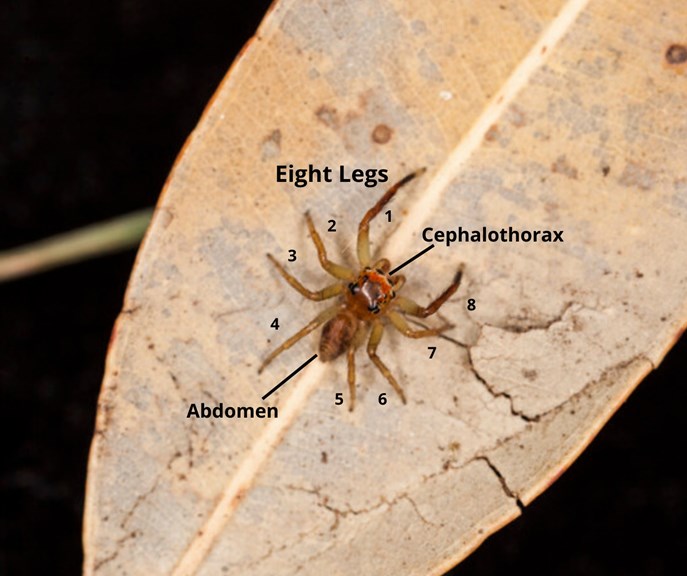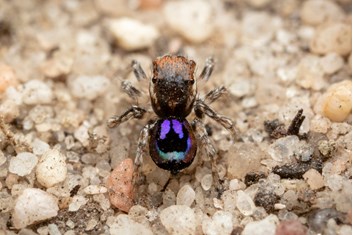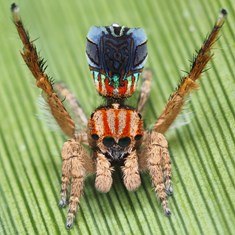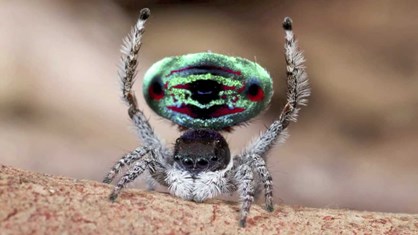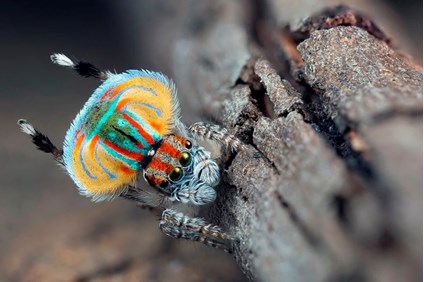Peacock spiders
Suitable for students Kinder–Grade 4
Here at Museums Victoria we have been discovering lots about a very special type of spider called the peacock spider. Peacock spiders are unique to Australia and can be found in backyards across the country.
They are known for the colorful patterns on their abdomens and their interesting courtship dances.
Watch the video below to meet Museum Victoria’s very own ‘Spider-Man’ Joseph Schubert and learn more about these disco-dancing spiders.
Did you know that Spiders belong to a class of bugs called arachnids?
All spiders have eight legs and two main body parts – the cephalothorax and the abdomen.
Most spiders have eight eyes, and spin webs with silk that is created from spinneret glands in their abdomen.
For our next activity we are going to design and label our very own peacock spider!
Begin by looking through the images of the peacock spiders below.
What do you notice about their colourful abdomens? Can you count their eight legs?
Click on the images to enlarge them!
Now let’s have a go at designing and labelling our own peacock spiders!
Colour or decorate the abdomen of your peacock spider. You might like to base your design on one of the spiders in the photos above or you might like to create your own unique design.
Next, have a go at labelling the different part of the spider.
- Can you count eight legs and eight eyes?
- Can you label the cephalothorax and abdomen?
Victorian Curriculum Links
Science Levels K–4
F–2: Biological sciences
- Living things have a variety of external features and live in different places where their basic needs, including food, water and shelter, are met (VCSSU042)
Level 3 & 4: Biological sciences
- Living things can be grouped on the basis of observable features and can be distinguished from non-living things (VCSSU057)
- Different living things have different life cycles and depend on each other and the environment to survive (VCSSU058)
Victorian Early Years Learning and Development Framework
| Outcome | Evidence Marker |
|---|---|
| Children have a strong sense of identity | Children develop their emerging autonomy, inter-dependence, resilience and sense of agency |
| Children are connected with, and contribute to, their world | Children become socially responsible and show respect for the environment |
| Children are effective communicators | Children use information and communication technologies to access information, investigate ideas and represent their thinking |
| Children are effective communicator | Children express ideas and make meaning using a range of media |
| Children are confident and involved learners | Children develop dispositions for learning such as curiosity, cooperation, confidence, creativity, commitment enthusiasm, persistence, imagination and reflexivity |
| Children are confident and involved learners | Children develop a range of skills and processes such as problem solving, inquiry, experimentation, hypothesising, researching and investigating |
| Children are confident and involved learners | Children transfer and adapt what they have learnt from one context to another |
| Children are confident and involved learners | Children resource their own learning through connecting with people, place, technologies and natural and processed materials |
